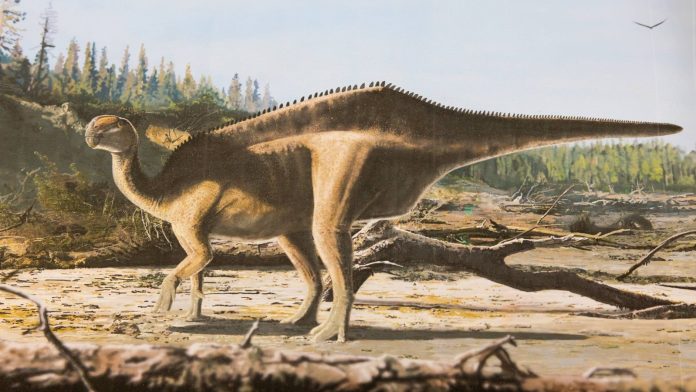
Unearthing a Dinosaur Dance: The Tale of Istiorachis macaruthurae and Its Eye-Catching Sail
Imagine wandering the rugged, windswept shores of the Isle of Wight, an English island where seagulls wheel overhead and the salty breeze carries echoes of ancient epochs. Beneath your feet lie secrets buried for 125 million years—prehistoric tales of giants that once roamed these now-tamed lands. And just recently, a new chapter of this primeval saga was unveiled: a dinosaur species with a spectacular, sail-like feature gliding along its back and tail, possibly the “peacock’s feather” of the Cretaceous period. This is the story of Istiorachis macaruthurae, a creature as visually striking as its name suggests.
The Genesis of a Discovery: In the Hands of a Young Scientist
At the heart of this discovery is Jeremy Lockwood, a passionate PhD student working with the University of Portsmouth and the Natural History Museum. Jeremy’s deep dive into the dusty vaults of long-forgotten fossils—bones tucked away in collections for decades—has sparked a revival. “No one had really taken a close look at these bones before,” Lockwood recalls, half incredulous at what his curiosity unveiled. What was once dismissed as an ordinary specimen from an already identified species turned out to be something entirely new, thanks to one daring detail: unusually elongated neural spines—that is, the bony projections rising from the dinosaur’s vertebrae.
“It was these spines,” Jeremy explains, “that suggested a sail-like structure stretching along the back and tail—something quite unprecedented within iguanodontian dinosaurs found in this region.”
His findings, recently published in the reputable Papers in Palaeontology, have shaken up our understanding of these herbivorous dinosaurs who roamed the Early Cretaceous landscape of what is now southern England.
What’s in a Name? Sailing into History with Ellen MacArthur
True to the Isle of Wight’s maritime heritage, Jeremy chose to honor one of the island’s most extraordinary modern icons. Rather than adopting a flashy Latin term full of complex roots, the new dinosaur carries the name Istiorachis macaruthurae. The first part, meaning “sail spine,” vividly conjures the image of that dinosaur’s most distinctive feature. The second pays respect to Dame Ellen MacArthur, a celebrated sailor from the Isle of Wight who, back in 2005, broke records by completing the fastest solo, non-stop circumnavigation of the globe.
“Naming this ancient beast after Ellen MacArthur felt right,” Lockwood shares with a smile. “It connects past and present—two voyagers separated by millions of years but bound by this island’s spirit.”
The Purpose of the Sail: More Than Just Heat Regulation
The peculiar sail structure has puzzled paleontologists for ages. Was it a built-in radiator to regulate body temperature? A bulky fat reserve during lean times? Jeremy and other experts have leaned heavily toward an explanation grounded in the nuances of animal behavior: sexual selection.
“Evolution often favors the dazzling over the merely functional,” explains Dr. Lockwood. “In living reptiles today, such sail or crest features usually show up predominantly in males, hinting that these physical traits evolved—much like the extravagant plumage of peacocks—to attract mates or intimidate rivals.”
This insight turns the gaze away from cold, pragmatic survival strategies toward a world of social interplay and visual spectacle. Imagine, beneath a prehistoric canopy, a male Istiorachis displaying his flaming “sail” in a courtship dance, vying for attention amidst towering ferns and shimmering rivers.
The Bigger Picture: Piecing Together Ancient Ecosystems
While Jeremy Lockwood’s find is remarkable in itself, it is also emblematic of the untapped riches stored in museum collections. Professor Susannah Maidment of the Natural History Museum points out how this discovery underlines the vital importance of maintaining and revisiting fossil archives.
“Jeremy’s meticulous work breathes new life into fossils that have sat quietly for years,” she notes. “By reevaluating these specimens with fresh questions and advanced techniques, he’s underscored how much remains to be learned about the diversity of iguanodontians on the Isle of Wight and, by extension, the Early Cretaceous ecosystems in the UK.”
Indeed, in just five years, Jeremy has quadrupled the known diversity of smaller iguanodontian dinosaurs from this region, reshaping scientific perspectives and opening windows into the rich tapestry of life from 125 million years ago.
Why Should We Care? The Relevance of Ancient Stories Today
As you sit reading this, have you ever reflected on how ancient narratives connect us all—across continents, species, and epochs? Fossils like those of Istiorachis macaruthurae remind us that Earth’s story is a vast, winding journey full of surprises. Each discovery challenges what we think we know and sparks curiosity about the forces guiding life’s vivid parade.
The sail of Istiorachis is not just a biological curiosity—it offers a glimpse into the social lives of creatures long extinct, reminding us that beauty, attraction, and competition are timeless themes woven into life’s fabric.
And from a broader perspective, such findings speak volumes about conservation and the significance of preserving natural history. They illustrate how we, as a global community, can learn from ancient ecosystems to better understand biodiversity, adaptation, and the fragility of our planet.
Questions to Ponder
- How might understanding the behavior and evolution of extinct species influence our view of modern wildlife and conservation?
- What undiscovered stories might lie hidden in museum drawers and fossil beds around the world, waiting for curious minds to unlock them?
- In an age of climate emergency, can ancient clues from species like Istiorachis help us predict and mitigate how life adapts to rapid environmental changes?
As scholars like Jeremy Lockwood continue their patient unearthing of the past, we are invited not only to marvel but to participate—to see ourselves as part of an ongoing story that spans millions of years, continents, and countless lives.
Final Reflections
In the Isle of Wight’s fossil-filled soil, the silhouette of Istiorachis macaruthurae stands tall—its sail a beacon for science, heritage, and imagination. This dinosaur reminds us how nature loves to decorate itself in bold hues and shapes, often for reasons more social and emotional than purely functional. And as we celebrate this discovery, we remember that science thrives on the inquisitive spirit, the joy of unearthing the new from the old.
So, next time you gaze at a creature (modern or ancient), consider what unseen dances, struggles, and displays might shape its existence. What stories lie behind every extraordinary feature? The world, it seems, still has many tales to tell—both in the pages of science and in the sails of ancient dinosaurs.







